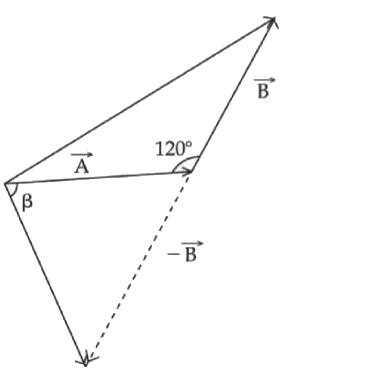What is the angle between →A and the rsultant of (→AˆB) and (→A−ˆB) ?
A
0∘
B
tan−1(AB)
C
tan−1(BA)
D
tan−1(A−BA+B)
Video Solution
Text Solution
The correct Answer is:A
→R=(→A+veB)+(→A−→B)+(→A−→B)
→R=2→A
Thus →R and →A are in same direction.
|
Topper's Solved these Questions
- BASIC MATHSBook:ALLENChapter:BASIC MATHSExercise:EXERCISE-2
Explore 80 Videos
- BASIC MATHSBook:ALLENChapter:BASIC MATHSExercise:EXERCISE-3
Explore 20 Videos
- BASIC MATHSBook:ALLENChapter:BASIC MATHSExercise:Question
Explore 1 Video
- AIIMS 2019Book:ALLENChapter:AIIMS 2019Exercise:PHYSICS
Explore 40 Videos
- CIRCULAR MOTIONBook:ALLENChapter:CIRCULAR MOTIONExercise:EXERCISE (J-A)
Explore 6 Videos
Similar Questions
Knowledge Check
What is the angle between →a and the resultant of →a+→b and →a−→b ?
A0Btan−1abCtan−1baDtan−1(a−b)(a+b)Assertion: If θ be the angle between →A and →B then tanθ=→A×→B→A.→B
Reason: →A×→B is perpendicular to →A.→BAIf both assetion and reason are true and the reason is the correct explanation of the assertion.BIf both assertion and reason are true but reason is not the correct explanation of the assertionCIf assertion is true but reason is falseDIf the assertion and reason both are false.The angle between (→A×→B) and (→B×→A) is :
AzeroBπCπ/4D2π/3
The angle between vector (→A) and (→A−→B) is :

View Solutionwhat is the angle between →aand→b,if→a.→b=3and∣∣→a×→b∣∣=3√3.
View SolutionGiven that A=B. What is the angle between (→A+→B) and (→A−→B) ?
View SolutionThe angle between vectors (→A×→B)and(→B×→A) is :
View SolutionIf θ is the angle between unit vectors →A and →B, then (1−→A.→B)1+→A.→B⎞⎟ ⎟⎠ is equal to
View Solution